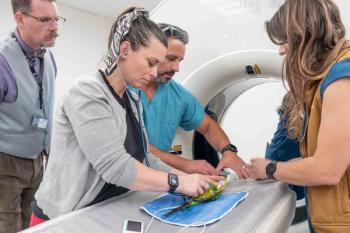
Neuroimaging (Proceedings)
The explosion of magnetic resonance imaging (MRI) has revolutionized neuroimaging. However, other modalities still are valuable when looking at the central nervous system. These include ultrasound and computed tomography (CT). Radiographs have limited usefulness due to the superimposition of structures associated with the cranial vault and vertebral column.
The explosion of magnetic resonance imaging (MRI) has revolutionized neuroimaging. However, other modalities still are valuable when looking at the central nervous system. These include ultrasound and computed tomography (CT). Radiographs have limited usefulness due to the superimposition of structures associated with the cranial vault and vertebral column. Though radiographs are still the primary modality of choice when triaging a fracture. The purpose of this talk to show the benefits of advanced modalities such as ultrasound, CT and MRI for evaluating the nervous system.
Ultrasound is a unique modality since it is non-invasive and readily available to veterinarians. The drawback is that the modality is very user dependent and the images can be difficult to interpret. Since ultrasound uses sound waves to generate an image, the other, and most substantial drawback, is the inability to penetrate bone. For patient preparation, the head can be shaved to optimize the contact between the skull and the ultrasound probe. In addition, acoustic coupling gel is used. A high frequency linear transducer is usually used for the evaluation, but a microconvexed curvilinear probe can also be used. Care must be made not to use isopropyl alcohol near the eyes of the patient.
When imaging the skull with ultrasound, an open fontanel is preferred. This lack of fusion of the bone plates of the calvaria allows for a window though the top portion of the head to allow for the identification of the lateral ventricles, the cerebrum and the pituitary gland. Lateral ventricle to brain ratios can be performed to measure the overall size of the ventricles to the head. In most dogs, a ratio of 30% is considered to be severe enlargement; however, with small breed dogs, a ratio greater than 60% is usually needed for clinical signs.
Computed tomography is a modality that uses x-rays to generate an image and is therefore much more intuitive to perform and interpret compared to ultrasound and MRI. The difference between CT and conventional radiography is that with CT, the x-ray tube circles the patient creating a 360-degree image of a region. Then the patient is moved and another image is generated. This eliminates the superimposition seen during radiography, but uses the same opacities as seen with radiographs. Because such a large amount of information is obtained, it is now possible to determine the difference between hemorrhage, mineralized disc herniation, water, fat even see sinusitis. These differences in soft tissue are improved when intravenous contrast medium is used. This iodine-based contrast medium enhances structures with a blood supply and helps separate subtle fluid and soft tissue differences that cannot be seen with conventional radiographs. In addition, due to neovascularization present with tumors, generally tumors of the central nervous system, such as meningiomas and metastatic disease, will enhance with contrast medium making them obvious to identify.
Magnetic resonance imaging is a modality unlike anything we have available. By using a magnet, we are able to align the protons in the body. Then, by adding a radiofrequency pulse, we impart energy into the tissues and look for the different relaxation characteristics. This has allowed us to have soft tissue detail that has never been realized before, as well as a relatively non-invasive method to look for edema and evaluate the spinal cord, without the need for contrast medium. Using MRI requires a large amount of training because different sequences can be performed to evaluate fat, fluid and soft tissue as well as specialized sequences like Fluid Attenuating Inversion Recovery (FLAIR) sequences that show high protein content fluid, but not normal cerebrospinal fluid (CSF). Magnetic resonance images are based on signal intensity, which also provides a different realm of interpretation. Therefore, despite the relative increase in availability of MRI, a large amount of work is still being done in order to optimize MR imaging as well as understand and properly interpret the images obtained.
By far, radiographs still remain the primary method for neuroimaging in the veterinary patient. It is rapid, readily available, does not require general anesthesia and requires minimal training to perform the technique. The infrastructure is already present in most hospitals and therefore, there is no new equipment to buy or learn about. The anatomy of the vertebral canal is complicated and therefore, care must be made to obtain straight radiographs. Over-interpretation can also be a problem, so orthogonal projections (images made at 90 degrees to each other) or myelography (contrast medium in the subarachnoid space) can be used to help evaluate the spinal cord. With radiographs, the spinal cord is not seen. The epidural fat, subarachnoid space with CSF, and the spinal cord have approximately the same opacity. Then, since they are surrounded by bone, the vertebral canal is seen, but not the cord itself. Therefore, compressive lesions, herniated disc material, even malformations and infections, like discospondylitis can be seen on a radiograph, but the effect on the spinal cord is not known unless CT, MRI or myelography is performed.
The veterinarian has numerous choices when evaluating the neurologic system in patients. By far, the most important diagnostic test a veterinarian will perform is a thorough neurologic examination. Any other diagnostic test, ultrasound, CT, MRI or even radiographs, may find lesions, but if they do not fit the clinical signs, these findings may be incidental or chronic and not causing the current condition. After neurolocalization, the choice will be what modality is available and which modality will provide the most information to confirm the differential diagnosis suspected. For example, meningitis is usually not detected during CT; however, if you have a patient with acute onset of neck pain and seizures, the CT would be performed to rule out compressive lesions or tumors and, while the patient is under general anesthesia, CSF can be obtained to confirm your differential diagnosis of meningitis.
The role of neuroimaging in veterinary medicine is growing quickly. Due to the availability of advanced imaging centers as well as the willingness for clients to pursue advanced diagnostics, it is clear that all of the modalities we have available will play a vital role in helping the neurologic patient. The goal of this talk is to provide an overview of what is available as well as common diseases that can be seen and diagnosed with each modality.
Newsletter
From exam room tips to practice management insights, get trusted veterinary news delivered straight to your inbox—subscribe to dvm360.






